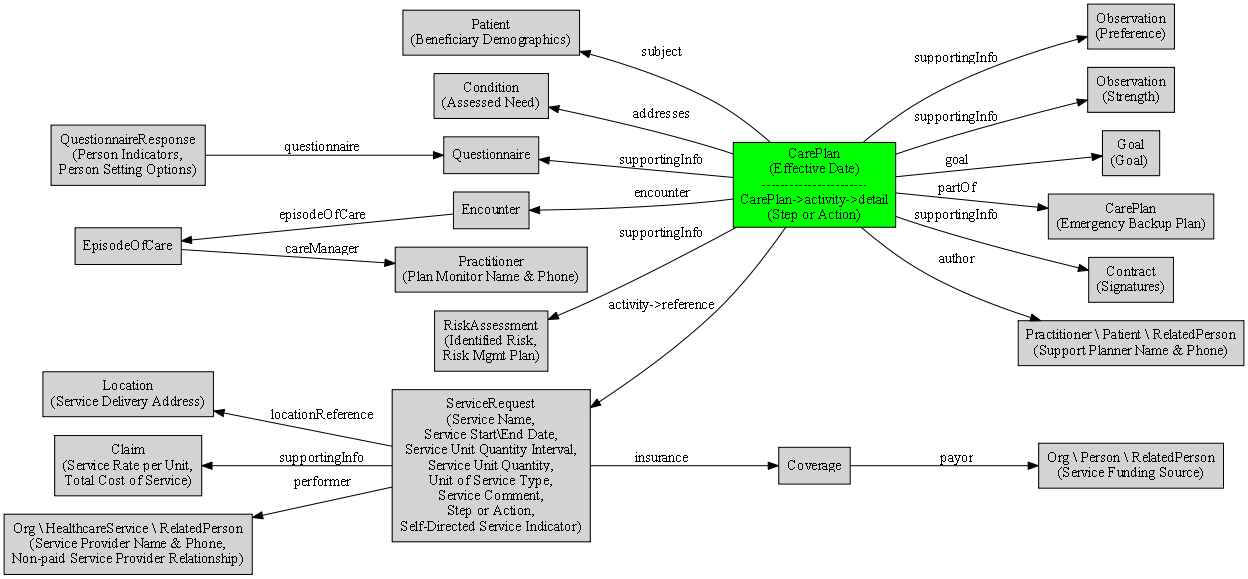This page is part of the electronic Long-Term Services and Supports Implementation Guide (v1.0.0: STU 1) based on FHIR (HL7® FHIR® Standard) R4. The current version which supersedes this version is 2.0.0. For a full list of available versions, see the Directory of published versions
The electronic Long-Term Services and Supports (eLTSS) Implementation Guide (IG) is based on FHIR R4. It was developed to support exchange of data generated during the planning and provision of long-term services and supports and is currently scoped to data commonly found on LTSS service plans.
Long-term services and supports (LTSS) are needed by millions of people, including children, adults and individuals over age 65, due to various disabling conditions and chronic illnesses. Long-term services are comprised of a diverse set of assistances designed to help with general care, activities of daily living (ADLs), and instrumental activities of daily living (IADLs) like eating, toileting, dressing, cooking, driving, managing money, etc. These services are provided across various settings from facility-based or institutional care to community-based settings. Services and supports provided in the person’s home or in a community setting are referred to as Community-Based Long-Term Services and Supports (CB-LTSS) or Home and Community-Based Services (HCBS).
The eLTSS data is currently and primarily used by LTSS service providers and care managers and resides in case management systems and LTSS provider systems. This IG is designed to streamline the ability to exchange and make this data available to all members participating in the care of the beneficiary (patient) including clinical and non-clinical care providers as well as the beneficiary and their representative(s).
The eLTSS data referenced in this implementation guide refers to the eLTSS Dataset that was developed by the eLTSS Initiative, a joint project between the Office of the National Coordinator for Health Information Technology (ONC) and the Centers for Medicare and Medicaid Services (CMS). The eLTSS Dataset was input for the Informative Document titled “HL7 Cross-Paradigm Information Sharing for Electronic Long-Term Services and Supports (eLTSS), Release 1” balloted during the September 2018 cycle. This IG further advances the eLTSS Dataset to FHIR mapping found in the Informative Document to provide FHIR-specific implementer guidance.
For more information, please see the Project Background and the eLTSS Use Cases included in this Guide.
The scope of this implementation guide is to describe how LTSS (also referred to as Home and Community-Based Service (HCBS)) data requirements, documented in the 56 data elements included in the eLTSS Dataset, can be represented for exchange and sharing using FHIR.
The concept of an eLTSS service plan most closely aligns with the FHIR CarePlan resource, which is semantically a good fit. The diagram below shows the FHIR resources utilized in the mapping as well as the FHIR data elements used to link these resources. Parentheses indicates the eLTSS Dataset data element (e.g. Assessed Need, Preference) or group of elements (e.g. Beneficiary Demographics, Person Indicators). Lines indicate linkages between FHIR resources and are labeled with the FHIR data element that provides the reference.

The IG will use FHIR R4, and FHIR US Core as a starting point and will profile resources as necessary to enable eLTSS Plan Creation and Exchange. Please refer to eLTSS FHIR Profiles for additional details.
For a detailed view of how eLTSS maps to FHIR R4, please refer to the eLTSS Dataset to FHIR Release 4 Mapping included in this guide.
Please note that implementations using this eLTSS FHIR IG must comply with US Core when applicable. US Core defines the minimum conformance requirements for accessing patient data as defined by the Argonaut pilot implementations and the ONC 2015 Edition Common Clinical Data Set (CCDS). These profiles are intended to be the foundation for US Realm FHIR implementation guides. Therefore, US Core Profiles, US Core Terminology, US Core Capability Statements / Conformance Requirements, and Security Considerations not specifically noted in this guide must be included when applicable. Please refer to the eLTSS Dataset to FHIR US Core Mapping included in this guide
The eLTSS Informative Document identified four actors who may be involved in the exchange of service plans. The list below outlines these actors and a brief description of their role in LTSS:
US Core defines two actors:
The eLTSS actors correspond to the US Core requestor actor when an eLTSS plan is exchanged using FHIR.
| Name | Role | Organization |
|---|---|---|
| Amber Patel | Author | Security Risk Solutions |
| Anastasia Perchem | Contributor | Office of the National Coordinator for Health Information Technology |
| Becky Angeles | Author | Carradora Health, Inc. |
| Bonnie Young | Contributor | Georgia Department of Community Health |
| David Pyke | Author | Ready Computing |
| Elizabeth Palena-Hall | Contributor | Office of the National Coordinator for Health Information Technology |
| Greg White | Author | Security Risk Solutions |
| Irina Connelly | Author | Georgia Tech Research Institute |
| Jack Wallace | Author | Georgia Tech Research Institute |
| Jamie Parker | Author | Carradora Health, Inc. |
| John Moehrke | Author | By Light Professional IT Services |
| Johnathan Coleman | Author | Security Risk Solutions |
| Kerry Lida | Contributor | Centers for Medicare & Medicaid Services |
| Mark Meadows | Contributor | Georgia Department of Community Health |